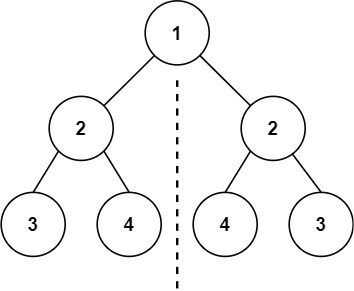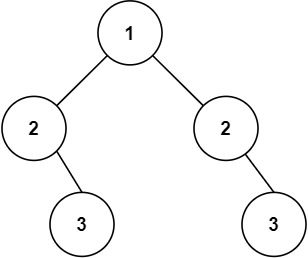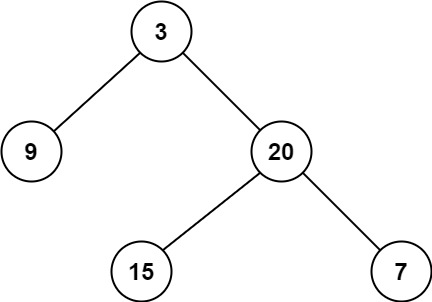题目1 226. 翻转二叉树
给你一棵二叉树的根节点 root ,翻转这棵二叉树,并返回其根节点。
示例 1:

输入:root = [4,2,7,1,3,6,9]
输出:[4,7,2,9,6,3,1]
示例 2:

输入:root = [2,1,3]
输出:[2,3,1]
示例 3:
输入:root = []
输出:[]
提示:
- 树中节点数目范围在
[0, 100]内 -100 <= Node.val <= 100
思路
这道题可以用先序,中序,后序或者层序遍历去做,思路都是类似的。
递归调用
注意递归结束条件是root为nullptr,在每个非空结点上进行左右孩子指针的交换就行了。
代码
/**
* Definition for a binary tree node.
* struct TreeNode {
* int val;
* TreeNode *left;
* TreeNode *right;
* TreeNode() : val(0), left(nullptr), right(nullptr) {}
* TreeNode(int x) : val(x), left(nullptr), right(nullptr) {}
* TreeNode(int x, TreeNode *left, TreeNode *right) : val(x), left(left), right(right) {}
* };
*/
class Solution {
public:
TreeNode* invertTree(TreeNode* root) {
if(root == nullptr) return root;
TreeNode* tmp = root->left;
root->left = root->right;
root->right = tmp;
invertTree(root->left);
invertTree(root->right);
return root;
}
};
迭代遍历翻转
使用一个辅助的栈或者队列来存储子结点就可以做了。
代码
class Solution {
public:
TreeNode* invertTree(TreeNode* root) {
stack<TreeNode*> nodeStack;
nodeStack.push(root);
while(!nodeStack.empty())
{
TreeNode* curNode = nodeStack.top();
nodeStack.pop();
if(curNode == nullptr)
continue;
nodeStack.push(curNode->left);
nodeStack.push(curNode->right);
swap(curNode->left, curNode->right);
}
return root;
}
};
题目2 101. 对称二叉树
给你一个二叉树的根节点 root , 检查它是否轴对称。
示例 1:

输入:root = [1,2,2,3,4,4,3]
输出:true
示例 2:

输入:root = [1,2,2,null,3,null,3]
输出:false
提示:
- 树中节点数目在范围
[1, 1000]内 -100 <= Node.val <= 100
思路
这道题就是将树拆分为左右两个子树,对子树进行相反方向的遍历比较就行了,可以使用递归法和迭代法,思路是类似的我用的是迭代法。
迭代法
class Solution {
public:
bool isSymmetric(TreeNode* root) {
if(!root->left && !root->right)
return true;
stack<TreeNode*> nodeStack1, nodeStack2;
nodeStack1.push(root->left);
nodeStack2.push(root->right);
while(!nodeStack1.empty() && !nodeStack2.empty())
{
TreeNode* lft = nodeStack1.top(),
* rht = nodeStack2.top();
nodeStack1.pop();
nodeStack2.pop();
if(!lft && !rht)
{
continue;
}
if(!lft || !rht || lft->val != rht->val)
return false;
#define PUSH(STACK, NODE, POSITION) \
STACK.push(NODE->POSITION);
PUSH(nodeStack1, lft, left);
PUSH(nodeStack1, lft, right);
PUSH(nodeStack2, rht, right);
PUSH(nodeStack2, rht, left);
#undef PUSH
}
return nodeStack1.empty() && nodeStack2.empty();
}
题目3 104. 二叉树的最大深度
给定一个二叉树 root ,返回其最大深度。
二叉树的 最大深度 是指从根节点到最远叶子节点的最长路径上的节点数。
示例 1:

输入:root = [3,9,20,null,null,15,7]
输出:3
示例 2:
输入:root = [1,null,2]
输出:2
提示:
- 树中节点的数量在
[0, 104]区间内。 -100 <= Node.val <= 100
思路
这道题可以用递归法(前,后序遍历)或者迭代法(层序遍历)来计算出深度,基础题。
递归法
/**
* Definition for a binary tree node.
* struct TreeNode {
* int val;
* TreeNode *left;
* TreeNode *right;
* TreeNode() : val(0), left(nullptr), right(nullptr) {}
* TreeNode(int x) : val(x), left(nullptr), right(nullptr) {}
* TreeNode(int x, TreeNode *left, TreeNode *right) : val(x), left(left), right(right) {}
* };
*/
class Solution {
public:
int Nextdepth(TreeNode* root)
{
if(!root)
{
return 0;
}
return 1 + max(Nextdepth(root->left), Nextdepth(root->right));
}
int maxDepth(TreeNode* root) {
return Nextdepth(root);
}
};
迭代法
class Solution {
public:
int maxDepth(TreeNode* root) {
if(!root)
return 0;
queue<TreeNode*> nodeQueue;
nodeQueue.push(root);
int depth = 0;
while(!nodeQueue.empty())
{
int num = nodeQueue.size();
for(int i = 0; i < num; i++)
{
TreeNode* node = nodeQueue.front();
nodeQueue.pop();
if(node->left)
nodeQueue.push(node->left);
if(node->right)
nodeQueue.push(node->right);
}
depth++;
}
return depth;
}
};
题目4 111. 二叉树的最小深度
给定一个二叉树,找出其最小深度。
最小深度是从根节点到最近叶子节点的最短路径上的节点数量。
说明:叶子节点是指没有子节点的节点。
示例 1:

输入:root = [3,9,20,null,null,15,7]
输出:2
示例 2:
输入:root = [2,null,3,null,4,null,5,null,6]
输出:5
提示:
- 树中节点数的范围在
[0, 105]内 -1000 <= Node.val <= 1000
思路
和最大深度类似考察基本功,用递归法遍历每一个结点获取最小深度之后累加得到结果;或者用层序遍历迭代到最浅的无双child节点终止。
递归法
class Solution {
public:
int NextDepth(TreeNode* root)
{
if(!root)
return 0;
if(!root->left && root->right)
return 1 + NextDepth(root->right);
if(root->left && !root->right)
return 1 + NextDepth(root->left);
return 1 + min(NextDepth(root->left), NextDepth(root->right));
}
int minDepth(TreeNode* root) {
if(!root)
return 0;
return NextDepth(root);
}
};
迭代法
class Solution {
public:
int minDepth(TreeNode* root) {
if(!root)
return 0;
queue<TreeNode*> nodeQueue;
nodeQueue.push(root);
int result = 0;
while(!nodeQueue.empty())
{
int num = nodeQueue.size();
for(int i = 0; i < num; i++)
{
TreeNode* curNode = nodeQueue.front();
nodeQueue.pop();
//若节点无左右child,则为最浅的节点,返回最小深度
if(!curNode->left && !curNode->right)
{
return result + 1;
}
if(curNode->left)
nodeQueue.push(curNode->left);
if(curNode->right)
nodeQueue.push(curNode->right);
}
result++;
}
return result;
}
};